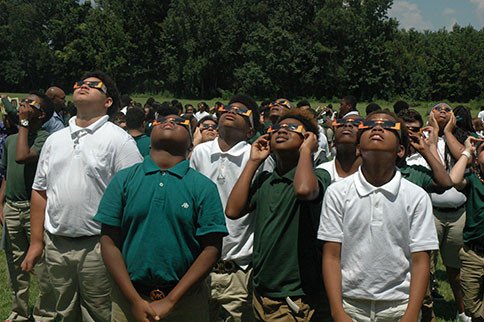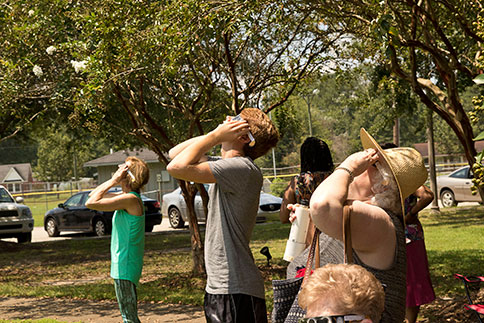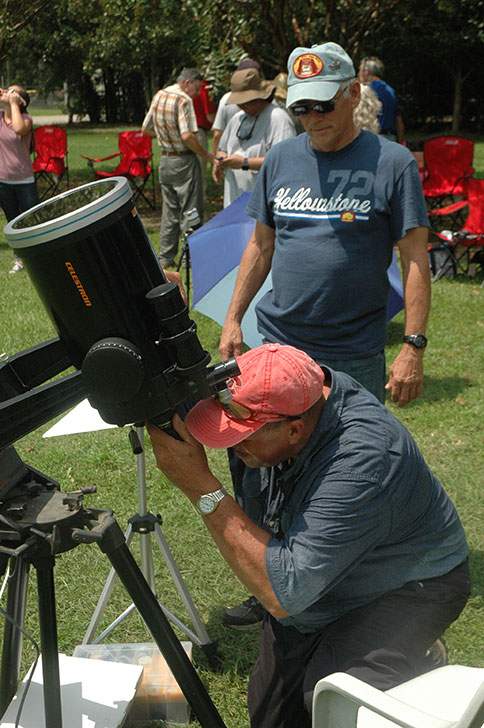
Although thick clouds moved in to block the final moments of Monday’s solar eclipse, Atmore residents were more than content to have witnessed the majority of the celestial event.
Monday’s solar shadowing made it the first solar eclipse visible in the United States since 1979, and millions went outside to view the astronomical aberration that occurs when the Earth’s orbit intersects the path of the moon, and the moon’s shadow blocks most of the sun’s radiance.
Around 40 people gathered at Heritage Park for a viewing party hosted by Schuyler Allen and Randy Clark, who provided two solar-filtered telescopes to project the progression of the eclipse onto cardboard. They also provided special eclipse-watching glasses for those in attendance.
“It’s exhilarating; it feels like dusk at midday,” said Joshua Ledford, who said that he and his companion, Olivia Brown, were the first to arrive at the sky-watching event. “We got here at about 10:50 (a.m., for 12:30 p.m. event). I was surprised because I would have thought that people would have camped out all night.”
Brown noted the changes that were gradually evolving as the sun took a backseat to Earth’s only natural satellite.
“Amazing, that’s one adjective that comes to mind,” she said as she gazed skyward. “You can notice the change, too. The sky’s getting a little dusty and it’s starting to darken. The (party) atmosphere makes it even better. We couldn’t find solar glasses, and we saw on the Atmore News Facebook page that Schuyler was hosting a viewing party. We both said, ‘We need to go to this,’ and we were the first ones here.”
The temporary taming of the sun’s glare caused temperatures to drop by several degrees as our universe’s largest star struggled to break free from the moon shadow.
Allen said he and Clark were pleased with the turnout for the rare occurrence.
“We’ve been pleased with the crowd,” the avid amateur astronomer said as the party began to break up shortly before 2 p.m., when cloud cover all but obliterated the eclipse’s final stages. “Actually this is the most I’ve ever seen of a solar eclipse. I had always missed the moment of totality, but we got pretty close today. We appreciate the people coming out. We could do this by ourselves, but it’s not as much fun.”
Although it was billed as a science class project, fun was the prevailing attitude at Escambia County Middle School, too, as more than 400 students in grades 5-8 and more than 100 parents viewed the solar spectacle.
Sharonda Smith, who was at the school to view the eclipse with her son, Jeremiah Brown, said she had never witnessed a solar eclipse before. But Beth Drew, assistant superintendent for the county’s public school system, recalled the last one that made a U.S. appearance.
“It’s pretty cool,” Drew said. “I can remember the eclipse in ’79, and it was cool, too. We’ve got kids lined up all the way down this hall, waiting to see it, and we’ve got a lot of parents. We’ve got the safety glasses, but I don’t think you could really make yourself look at it at all without glasses. Your eyes would reflexively shut. Maybe if it was near totality and there was just a little bit left.”
Drew said several other county schools allowed students in older grades to witness the phenomena. “We did not let any students under fourth grade even try,” she pointed out.
Another local viewing party took place at Atmore Public Library, where adults and children were treated to NASA.gov’s live online stream of the eclipse’s progression.
Library Director Hope Lassiter said as she tried to get a glimpse of the moment of totality through the thick rain clouds that gathered overhead around 2 p.m. that the crowd was thin, but those in attendance got to see a rare occurrence.
“Escambia Academy had school today, but said any student would be excused if they came to watch the eclipse,” said Lassiter. “We also had students from Atmore Baptist Temple and a few others.”
ECMS Principal Deborah Bolden said she had some misgivings about allowing the viewing at her school, but decided it was an opportunity the youngsters might not get again.
“I wasn’t going to do it, but I felt these students needed the opportunity,” said Bolden, who agreed that some of the younger students would be at or near the age their parents are now when the U.S.’s next solar eclipse occurs in April 2024.




